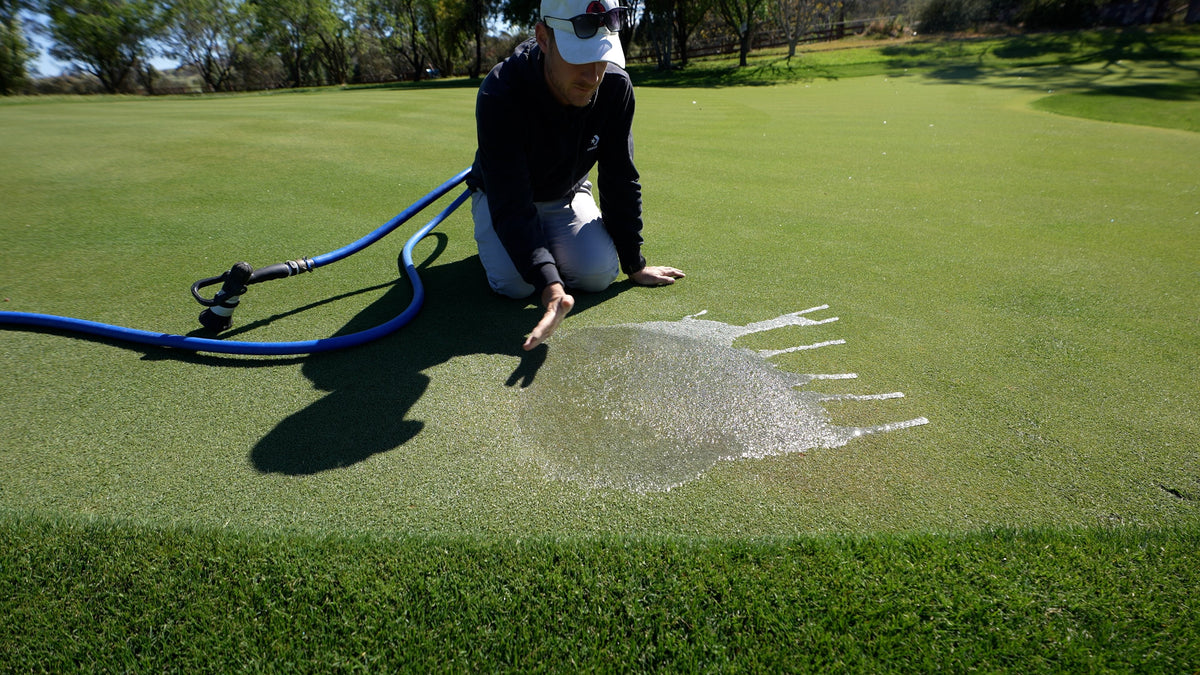
Do Wetting Agents Really Work? How to Improve Water Penetration
|
|
Time to read 4 min
|
|
Time to read 4 min
Watering your lawn should be simple, right? But if you're noticing dry patches, pooling, or runoff, even after regular watering, you might be dealing with hydrophobic soil. This is where a wetting agent comes in — and yes, it really does work.
A wetting agent is a product designed to reduce the surface tension of water, helping it spread and soak more evenly into the soil. In other words, it makes water "wetter." When applied to hydrophobic soil (soil that repels water), a wetting agent allows water to penetrate more effectively instead of sitting on the surface or running off.
Hydrophobic soil is a common issue in Australian lawns, especially in sandy or compacted soils. After periods of drought or inconsistent irrigation, the topsoil can become dry and waxy, which prevents moisture from soaking in. That’s where the consistent use of a wetting agent can make a dramatic difference.
If your lawn suffers from any of the following, it's likely time to apply a wetting agent:
Water runs off the surface without soaking in
Grass browns even though you’re watering regularly
Soil feels dry just below the surface
Water pools in some areas but leaves others dry
You see uneven growth or dry rings
A good wetting agent helps solve all these issues by ensuring moisture penetrates where it's needed — the root zone.
At a scientific level, wetting agents reduce the water's surface tension, allowing it to coat soil particles more evenly. This breaks the barrier that causes water to bead and run off. Once the soil is rehydrated, nutrients and water can be absorbed effectively by the grass roots.
There are two main types:
Penetrants – These push water deep into the soil quickly, ideal for fast relief of dry patches.
Surfactants – These help hold moisture in the root zone for longer periods.
Some modern products combine both types for a balanced approach.
The best time to apply a wetting agent is during the warmer months when the soil is dry and the lawn is actively growing. For most parts of Australia, this is typically between spring and early autumn .
Apply every 4–6 weeks during dry periods or as needed based on your lawn's condition. Wetting agents are most effective when followed by irrigation or rain to move the product into the soil profile.
Application is simple, but to get the most out of your wetting agent:
Apply in the early morning or late afternoon to avoid evaporation
Use a hose-on applicator or diluted sprayer
Water the lawn immediately after application if the product requires it
Reapply every 4–6 weeks during dry or hydrophobic conditions
Always follow the label for rate and timing instructions.
Pure Wetter combines high-quality penetrants and retainers to improve both short- and long-term water movement in the soil. It helps water soak evenly into the root zone while preventing future dry patch development.
Safe for all lawn types
Easy hose-on application
Helps reduce water waste and improves nutrient uptake
This makes it an ideal wetting agent for residential lawns, particularly during summer or in hydrophobic soils.
No — wetting agents enhance your watering routine but don’t replace it. Think of them as tools that help water get where it needs to go, more efficiently. You still need to maintain a proper watering schedule suited to your lawn type and climate.
However, using a wetting agent can reduce how often you need to water and make each watering far more effective, saving time, money, and water.
Besides fixing dry patches, wetting agents have several benefits:
Better fertiliser performance — nutrients are carried deeper into the root zone
More even growth — no more green patches surrounded by brown ones
Improved drought tolerance — roots stay hydrated longer
Reduced water waste — less runoff and evaporation
A: Yes — high-quality wetting agents like Pure Wetter are safe for buffalo, couch, kikuyu, zoysia, and even ryegrass. Just follow the application instructions.
A: It can definitely help. If the dry patches are caused by hydrophobic soil, a wetting agent will improve penetration. Combine it with aeration and proper watering for the best results.
A: Generally yes, but check product labels first. Many liquid fertilisers and wetting agents can be applied on the same day, as long as they’re watered in properly.
A: Spring through early autumn is ideal, especially during dry spells. Avoid applying in winter unless your soil is extremely dry or sandy and still needs help absorbing water.
Wetting agents reduce water’s surface tension, helping it soak evenly into dry or hydrophobic soil.
They’re ideal for lawns with dry patches, runoff issues, or uneven water absorption.
Applying a wetting agent improves irrigation efficiency, fertiliser uptake, and overall turf health.
Best applied every 4–6 weeks during the growing season or in dry conditions.
Pure Wetter is a professional-grade wetting agent safe for all lawn types.
Wetting agents don’t replace watering — they enhance it by making each application more effective.
Yes — wetting agents absolutely work. They help break through water-repellent soil, ensure more effective irrigation, and promote healthier, more resilient turf.
If you're serious about keeping your lawn green through the hottest parts of the year, applying a wetting agent like Pure Wetter every 4–6 weeks should be part of your core routine.
Want to learn more about how and when to apply it? Check out our Free Lawn Calendar to time your applications for the best results.

